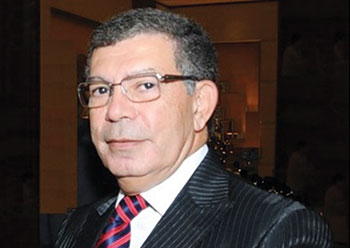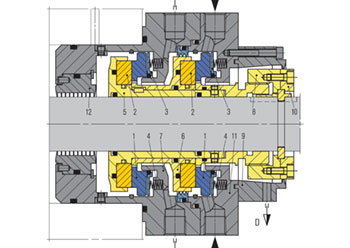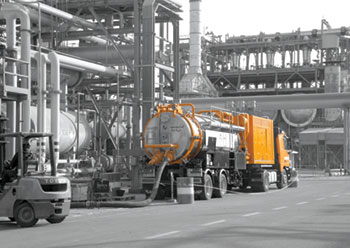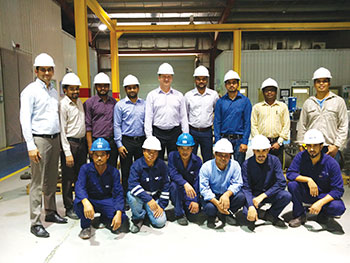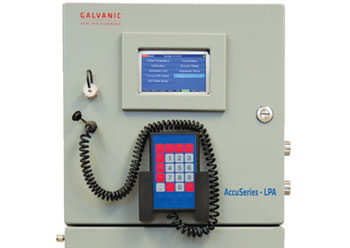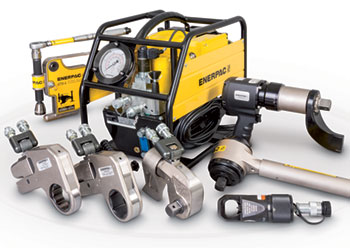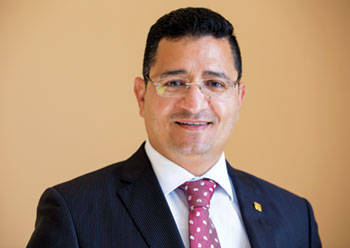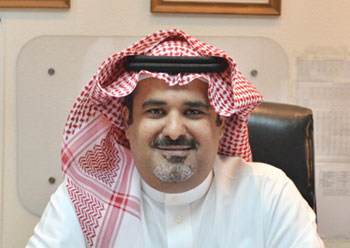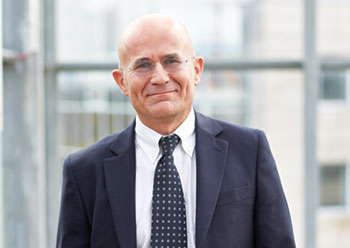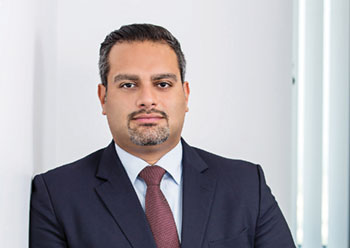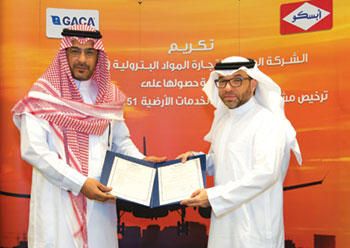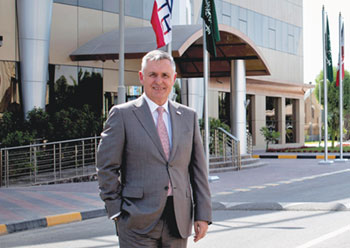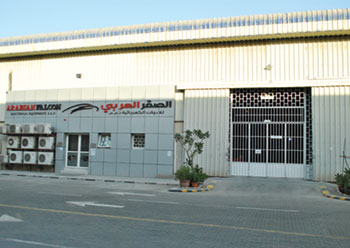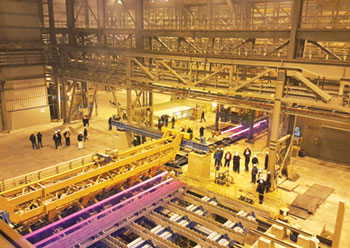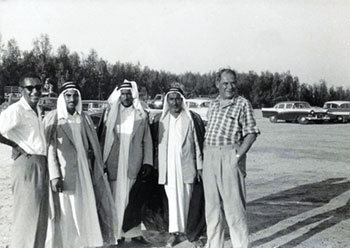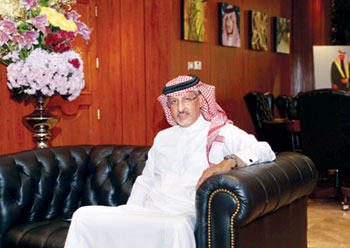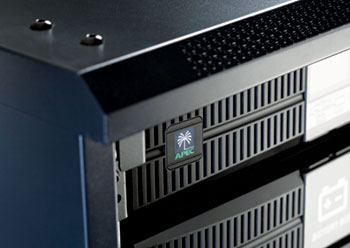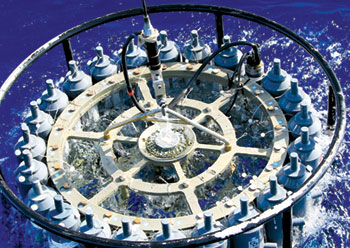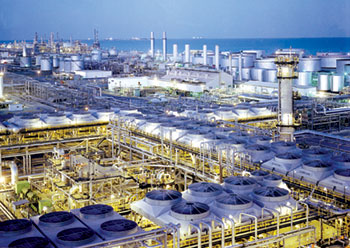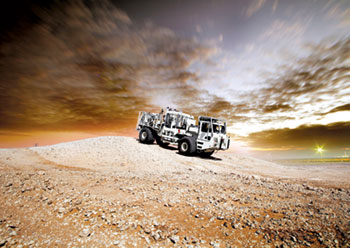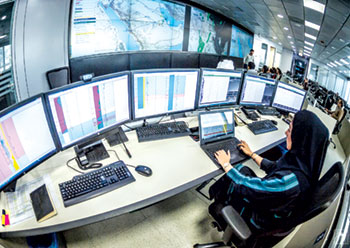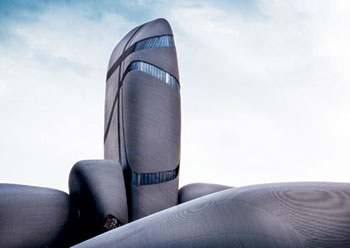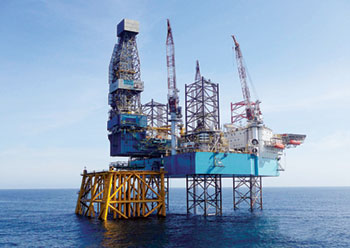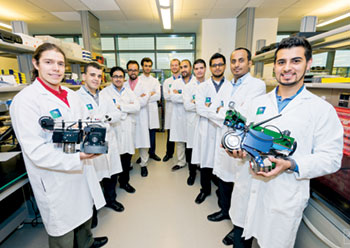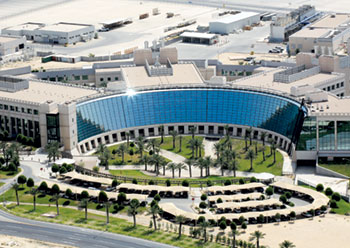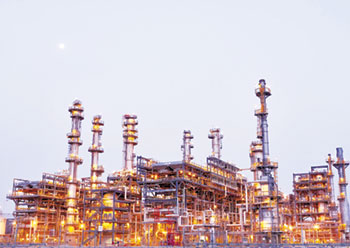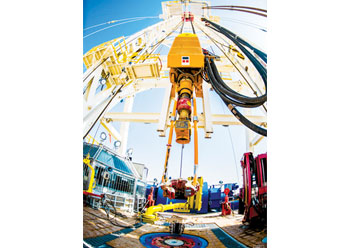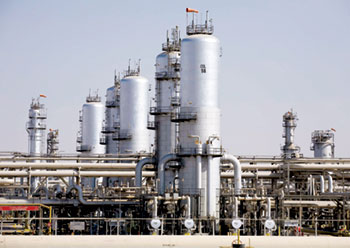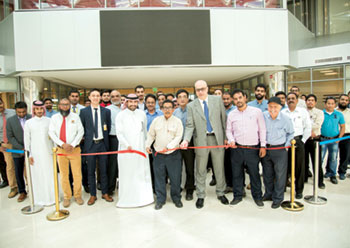
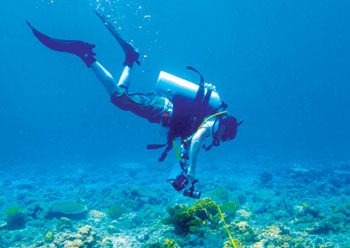 A diver inspecting the sea-bed
A diver inspecting the sea-bed
In the waters of the Arabian Gulf, the company’s Underwater Inspection and Repair Unit is busy
Sitting before a wide array of switches, dials, regulators, gauges and screens, Sultan Al Ahmadi’s eyes are a flurry of activity as they focus in on the many numbers and valves before him. He flicks a switch and adjusts a dial. He has to be precise. Any complacency or lack of attention to detail could prove fatal.
Al Ahmadi is on board the Zamil Six. Around 20 feet away, Abdullah F. Al Amiri feels the effects of Al Ahmadi’s actions. Al Amiri is sitting patiently inside a LARS a metal cage measuring 6 feet by 3 feet, as it stands perilously close to the edge.
The meshed cage that surrounds him is attached to a winch that will soon shift into gear and lower both the cage and occupant into the Arabian Gulf waters below. Donning a diving helmet that weighs approximately 15 kilogrammes, Al Amiri’s every move is tracked by a camera and two-way communication system that is part of his essential headgear, says a report in Dimensions.
It’s Al Ahmadi who is keeping a close eye on the whole proceedings, communicating directly via radio. "How much bailout pressure?" asks Al Ahmadi, referring to Al Amiri’s emergency supply of air. "190 bar, bailout checks complete, ready for main gas," is the response.
Al Amiri is a Saudi Aramco diver. As part of the Marine Department’s Underwater Inspection and Repair Unit (UIRU), his working world is subsea, among the marine and plant life of the Arabian Gulf. Today he is performing an underwater inspection of the Zamil Six. Along with fellow divers, their job is to inspect, repair, and maintain the integrity of company offshore assets, including barges, vessels, platforms, and pipelines.
His wingman on this job is Al Ahmadi, a diving supervisor who is responsible for the pre-dive safety checks and the dive and diver in general, from the time he leaves the surface to completing his decompression and reaching the surface again.
Before Al Amiri, or any diver for that matter, submerges, the diving supervisor must give the green light. The UIRU serves as Saudi Aramco’s eyes, ears and indeed hands, beneath the sea. Divers, equipped with a sniper’s vision, are dispatched to carry out detailed work in an environment that was not created for human interaction.
"The team amazes me," says Marine Department manager Mohammad A. Sultan. "They are always ready, no matter what it takes, to get the job done." The UIRU is a testament to Saudi Aramco’s efforts to ensure that its operations are optimal, efficient, and above all, safe – no matter the environment.
THE BRAIN
At the Tanajib pier, a heavy burst of rain sends workers dashing for cover. It’s been raining intermittently throughout the night. And like a perfectly tuned orchestra, waves follow the cue of the rainfall by flowing and thrusting themselves upon the hulls of docked vessels.
At the nearby administrative and maintenance buildings, employees enjoy the splendid downpour from the comfort of their offices.
 |
An oceanographic vessel |
At his desk, Petros Kogiamis is busy. His phone rings constantly. "Hello, diving" he answers. Another customer is on the line. UIRU services are in big demand and Kogiamis is the focal point. On any given day he can receive between 20 to 40 job requests, which are officially received through the Marine Department’s Marine Operations Management (MOM) system.
Rain or shine, the calls keep coming. "We receive the orders, evaluate, and then decide which vessel will do the job," says Kogiamis. The jobs vary in their requirements and complexity. To respond appropriately, at the unit’s disposal are five vessels that are able to operate in varying water depths – two shallow water vessels that operate in waters from 2½ to 15 metres; two diving support vessels that operate in waters ranging from 15 to 50 metres; and one saturation diving vessel that can operate in water depths ranging from 30 to 300 metres.
Each of the vessels also has portable diving equipment that can be utilised onboard purpose-built zodiacs. This allows the unit to reach extreme shallow areas up to the shoreline if need be. Kogiamis’s 32 years of diving experience mean the subsea is almost his second home. There’s not much he hasn’t seen in the world of professional diving.
It’s this experience that makes him a perfect fit for his role. In the hot seat, he assesses which vessels are available for the required jobs, in addition to dispatching instructions to divers and receiving operational updates.
It’s no surprise, then, that despite its inconspicuous appearance, his cubicle is known as "the brain." "I communicate with our colleagues on the vessels," he notes. "From here we can see and monitor everything in real time and we know exactly where the vessels are and what dive jobs they are working on.
It’s a 24-hour operation it doesn’t stop." An ounce of prevention is worth a pound of cure, the old adage goes. Each year, the unit runs a proactive campaign to inspect 650 kilometres of subsea pipelines in addition to 72 platforms – helping to prolong the life cycle of the assets. "By carrying out inspections we can spot any potential issues before they happen and intervene," notes Kogiamis.
"The subsea environment has many challenges, so keeping a close eye on things is crucially important." One of the vessels Kogiamis tracks is the Mermaid Asiana. On first appearances, there is nothing seemingly unusual about the vessel.
Certainly, the elevated helicopter deck that stands at the front of the vessel is eye-catching – but far from uncommon on large vessels. But it’s below deck, deep into the core of the purpose-built saturation diving support vessel, where on a daily basis, an operation that grapples with the laws of nature takes place. Yaqub Al Omoud says goodbye to his wife and six children.
They won’t be seeing him for at least six weeks. From the city of al-Hasa, the 34-year-old diver makes the journey by road and then air to Tanajib. Once at the pier, he will board the Mermaid Asiana.
Psychologically, Al Omoud must be prepared for what awaits him. For the next six to eight weeks this vessel will be his home. But Al Omoud won’t be sleeping below deck in a cabin. Nor will Al Omoud be found working on the deck or in the control room.
For up to eight hours per day Al Omoud will be underwater, inspecting and repairing Saudi Aramco assets. For the remaining 16 hours he will be in a saturation chamber – a high pressure habitat that he shares with up to six other divers. This is the pinnacle of diving.
Having just arrived at the Mermaid Asiana, he readies himself before entering the chamber. He has his books, electrical devices, and other essentials. The medic on board the vessel carries out the mandatory presaturation medical check – Al Omoud is good to go.
The saturation chamber is technology’s answer to the dilemma of being able to dispatch divers to depths of 100 metres, and more, at an instant’s notice and for prolonged periods of time, possibly for up to eight continuous hours. The saturation unit is pressurised to almost the same depth level at which the divers will be working subsea.
Inspecting company assets at such depths for long periods of time means that saturation divers need to stay in the water longer and deeper than conventional commercial divers. Regular commercial divers will work for around 20 to 90 minutes in shallower water depths up to 50 metres, then take around 40 minutes to resurface due to the necessary decompression stops along the way. If divers resurface too quickly they can suffer decompression sickness, which is the result of having breathed gas that is at a higher pressure than the surface pressure.
This happens when divers remain subsea for long periods at greater depth, without ascending gradually and making the decompression stops needed to slowly reduce the excess pressure of inert gases dissolved in the body. In the saturation unit Al Omoud and other divers will breathe a mixture of gases, including oxygen and helium.
Once the body is saturated it means the diver can be deployed from the saturation unit into the water, and more importantly, he can come straight back without the need for decompression stops.
Saturation divers are therefore able to work at greater depths for longer periods of time. "One of the biggest advantages of having a vessel like the Mermaid and its saturation divers is that they can be dispatched at a moment’s notice to deep depths – we don’t have to worry about the divers being saturated or getting decompressed on their return," notes superintendent of Marine Offshore Operations, Turki M. Shihri.
"This means we save time and money, but more importantly, it means we are always ready to deal with any situation." Al Omoud will be saturated in the same chamber where he sleeps and rests. To get to the seafloor he will exit his pressure chamber through an airlock and enter a diving bell.
The diving bell is then lowered to the seabed, or required working depth, and Al Omoud is released to work. Once finished, Al Omoud, or any other saturation diver, will reenter the bell, which is then hoisted back to the vessel. All the time, his world does not go beyond the subsea area and the saturation chamber. Saturation diving is all about depth and time. However, even operating in shallow waters can throw up the most challenging of scenarios.
But even in this instance, UIRU was to prove, that through ingenuity and technology, no challenge is unsurpassable.
A SHALLOW PROBLEM
Connected to an umbilical cord, a diver submerges to begin a shallow water inspection of a Saudi Aramco asset. The umbilical cord resembles a thick yellow rope, and serves as the conduit for a supply of diving gases.
It also contains reinforced wires allowing radio communication with the diver as well as providing light to the diver and a camera feed back to the surface dive panel. The cord is connected to a shallow water inspection vessel.
However, it must operate carefully, a host of potential problems await – not least the risk of impact with the sea bed or underwater obstacles in the shallow waters. It’s risky business.
Necessity is the mother of invention, and the UIRU turned to the company’s Research and Development Centre’s Intelligent Systems Lab for assistance. How could they inspect assets in shallow waters and avoid the potential hazards to the support vessels?
Seven engineers based within the Oil and Gas Network Integrity Division were assigned to work with three members of the Marine Department, and in less than two years they successfully developed the Shallow Water Inspection and Monitoring Robot (SWIM-R).
 |
Getting ready to dive |
The device is able to conduct visual inspections, marine life cleaning, ultrasonic thickness readings, and cathodic protection voltage measurements in shallow waters. Divers can now operate the vehicle remotely from onboard the dive vessels.
"This was a great leap," notes URIU head Khaldoun I. Bukhari. "It is a very effective way to carry out our operations in shallow waters and is a great example of collaboration between different departments."
One of the operators of SWIM-R is 28-year-old Shadi S. Negaimshi. He serves as a trainee diving supervisor, and also operates the technology from above the surface in a diving support vessel. "This was a breakthrough technology that was developed specifically for our operations," he notes. "Obviously, it gives me great pride to be part of its deployment – it shows that the company is always looking at innovative ways to tackle operational challenges."
Negaimshi is no stranger to serving the interests of the kingdom in fact he’s quite a pro. It was in 2008, when the eyes of the world were on Beijing, that he first stepped forward and represented Saudi Arabia at the Olympics as a freestyle swimmer. Four years later he joined UIRU as a diver.
"Water is my passion – I am doing something I love," he says with a brimming smile. Having received extensive training in the unit, Negaimshi is all too aware of the trust now placed on him. "The company has invested in me and it comes with a responsibility we must give 100 per cent all of the time and always be looking at ways in which we can improve our operations."
‘NEW CHALLENGES’
"There is a special relationship between me and the water," says Eyad T. Al Hajji, with a look of contemplation. The 40-year-old diver from Al-Khobar is rarely at his seat.
As a diving supervisor he is busy either overseeing dive operations on vessels, or in his office at the Tanajib pier ensuring tasks run smoothly.
In the world of Saudi Aramco marine operations, Al Hajji is a pioneer. When he joined Saudi Aramco’s diving operations in 2006 there were no other Saudis on the team. He would be the first – and a sign of things to come.
Not exactly the career path his professors at King Faisal University expected him to follow. "I graduated with a degree in English Literature," he reminisces. "I was not interested in becoming a teacher though – I wanted to do something that didn’t have a daily routine." Al Hajji, already an established swimmer by the time he graduated, followed his instincts and decided to take his affinity with the water to another level. He spotted an advertisement from a contractor company requiring divers – he was hooked.
Successfully recruited, extensive diver training in the United kingdom soon followed. Contracts with Saudi Aramco exposed Al Hajji’s skills to UIRU and they wasted no time in recruiting him. "I knew the job with Saudi Aramco would be exciting," he explains.
"It would present me with new challenges and I was ready to take them on. It was a source of immense pride for me to be the first Saudi diver for the company." A period of intense training was arranged that included a diving medic course and a programme in Nondestructive Testing/Subsea Inspection – crucial skills for Al Hajji’s line of work with the company.
"I always love to dive – you never know what you are going to face. That’s the beauty of this job. You are operating in an environment that is alien to human life – it’s not natural for humans to be under the water.
"Sometimes I would ask myself while subsurface ‘what am I doing here?’ But this environment brings out the best in human ingenuity." Despite his relatively young age, Al-Hajji is now considered a mentor in the unit. Younger Saudi blood is now stepping forward, carrying the torch first lit by the "pioneer."
TWO OF A KIND
As admin clerks with the Marine Technical Services Department, Musab A. Hmod and Metab Y. Otaif would find themselves at the heart of supporting the department’s operations. The pair both attended the Industrial Training Centre in Dhahran and joined their new organisation together.
One morning, like hundreds of others across their department, they received what seemed to be a regular email.
Yet it turned out to be the beginning of a new and exciting journey – one they would once again carry out together.
"I opened the email and it was a request from the department for anyone interested in becoming a diver to come forward," remembers Otaif. He immediately consulted with his close friend and colleague Hmod, who to no surprise, was also excited at the prospect of becoming a diver. "I saw this as my chance to go offshore," Hmod recalls.
"I wanted to work offshore – I am in love with the sea." Hmod and Otaif were part of a drive to internally recruit divers to join UIRU.










































































